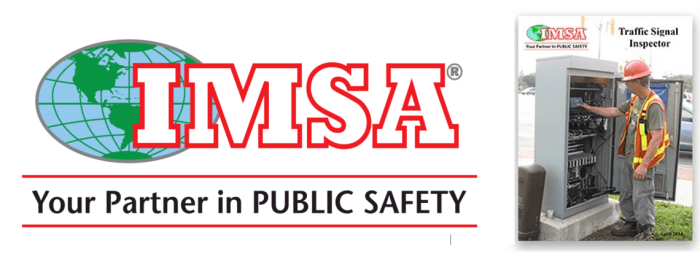Welcome to the comprehensive guide to IMSA Traffic Signal Technician Level 1. This document delves into the intricacies of this specialized field, providing a thorough understanding of its responsibilities, qualifications, career prospects, and industry standards. As we navigate through each section, you will gain valuable insights into the essential role played by IMSA Traffic Signal Technicians in ensuring the smooth and safe flow of traffic.
This guide is designed to empower you with the knowledge and understanding necessary to excel in this dynamic and rewarding profession. Whether you are a seasoned professional seeking to enhance your skills or an aspiring technician eager to embark on a fulfilling career path, this resource will serve as your trusted companion.
Job Description: Imsa Traffic Signal Technician Level 1

IMS Traffic Signal Technician Level 1 is responsible for maintaining, repairing, and installing traffic signals and related equipment. They work under the supervision of a higher-level technician or engineer and may lead a team of lower-level technicians.
To qualify for this position, individuals must possess a high school diploma or equivalent and have experience in electrical or electronics repair. They must also have a valid driver’s license and be able to work in all weather conditions.
Typical job duties include:
- Installing, repairing, and maintaining traffic signals, controllers, and other related equipment
- Troubleshooting electrical and electronic problems
- Performing routine maintenance and inspections
- Responding to emergency calls
- Working with other technicians and engineers to complete projects
Training and Certification, Imsa traffic signal technician level 1
IMS Traffic Signal Technician Level 1 must complete a training program that covers the following topics:
- Traffic signal theory and operation
- Electrical and electronic repair
- Traffic signal maintenance and troubleshooting
- Safety protocols
After completing the training program, technicians must pass a certification exam to obtain their IMS Traffic Signal Technician Level 1 certification. This certification is valid for three years and must be renewed by completing continuing education courses.
Benefits of obtaining this certification include:
- Increased job opportunities
- Higher earning potential
- Improved job safety
- Enhanced professional credibility
The process for obtaining and maintaining this certification is as follows:
- Complete the IMS Traffic Signal Technician Level 1 training program
- Pass the IMS Traffic Signal Technician Level 1 certification exam
- Renew the certification every three years by completing continuing education courses
Career Advancement
IMS Traffic Signal Technician Level 1 can advance their careers by obtaining additional training and certification. With experience and additional training, they can qualify for positions such as:
- IMS Traffic Signal Technician Level 2
- IMS Traffic Signal Technician Supervisor
- Traffic Signal Engineer
These positions offer higher salaries and more responsibility.
Industry Standards and Regulations
IMS Traffic Signal Technician Level 1 must adhere to the following industry standards and regulations:
- National Electrical Code (NEC)
- Institute of Transportation Engineers (ITE) standards
- Occupational Safety and Health Administration (OSHA) regulations
These standards and regulations ensure that traffic signals are installed and maintained safely and efficiently.
Equipment and Technology
IMS Traffic Signal Technician Level 1 use a variety of equipment and technology to perform their job duties. This equipment includes:
- Traffic signal controllers
- Traffic signal heads
- Traffic signal detectors
- Electrical test equipment
- Computer-aided design (CAD) software
This equipment and technology helps technicians to install, maintain, and troubleshoot traffic signals.
Safety Protocols
IMS Traffic Signal Technician Level 1 must follow strict safety protocols to protect themselves and others from injury. These protocols include:
- Wearing appropriate personal protective equipment (PPE)
- Working in a safe and well-lit area
- Using proper tools and equipment
- Following lockout/tagout procedures
- Being aware of potential hazards
By following these protocols, technicians can help to prevent accidents and injuries.
Troubleshooting and Problem-Solving
IMS Traffic Signal Technician Level 1 must be able to troubleshoot and solve problems with traffic signals. This requires them to have a good understanding of traffic signal theory and operation. They must also be able to use their problem-solving skills to identify and resolve issues.
Common problems that technicians may encounter include:
- Traffic signals that are not working properly
- Traffic signals that are out of sync
- Traffic signals that are damaged
Technicians can use their troubleshooting skills to identify the cause of the problem and develop a solution.
Communication and Teamwork
IMS Traffic Signal Technician Level 1 must be able to communicate effectively with other technicians, engineers, and the public. They must also be able to work as part of a team to complete projects.
Communication and teamwork are important for the following reasons:
- To ensure that everyone is on the same page
- To avoid mistakes
- To resolve problems quickly and efficiently
- To build strong relationships with colleagues
Technicians who are able to communicate effectively and work well as part of a team are more likely to be successful in their careers.
FAQ Section
What are the primary responsibilities of an IMSA Traffic Signal Technician Level 1?
IMSA Traffic Signal Technicians Level 1 are responsible for installing, maintaining, and repairing traffic signals, controllers, and other related equipment. They also perform routine inspections, troubleshoot problems, and respond to emergencies.
What are the required qualifications for this position?
To qualify for this position, individuals typically need a high school diploma or equivalent, along with some experience in electrical work or a related field. Additional training and certifications, such as the IMSA Traffic Signal Technician Level 1 certification, are highly recommended.
What are the career advancement opportunities for IMSA Traffic Signal Technician Level 1?
With experience and additional certifications, IMSA Traffic Signal Technicians Level 1 can advance to higher-level positions, such as Traffic Signal Supervisor or Traffic Signal Engineer. They may also specialize in specific areas, such as traffic signal design or intelligent transportation systems.

